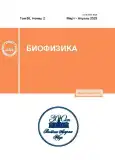Application of optical analysis methods for non-invasive monitoring of blood oxygen saturation level
- 作者: Guzenko M.M1, Mazing M.S1, Zaitseva A.Y.1
-
隶属关系:
- Institute for Analytical Instrumentation, Russian Academy of Sciences
- 期: 卷 68, 编号 2 (2023)
- 页面: 389-395
- 栏目: Articles
- URL: https://journals.rcsi.science/0006-3029/article/view/144437
- DOI: https://doi.org/10.31857/S0006302923020199
- EDN: https://elibrary.ru/CDEUXP
- ID: 144437
如何引用文章
全文:
详细
作者简介
M. Guzenko
Institute for Analytical Instrumentation, Russian Academy of Sciences
Email: maria51m@mail.ru
St. Petersburg, Russia
M. Mazing
Institute for Analytical Instrumentation, Russian Academy of SciencesSt. Petersburg, Russia
A. Zaitseva
Institute for Analytical Instrumentation, Russian Academy of SciencesSt. Petersburg, Russia
参考
- Л. П. Кислякова, А. Л. Буляница, Ю. Я. Кисляков и В. И. Гуляев, Научное приборостроение, 26 (2), 37 (2016).
- Yu. Ya. Kislyakov, S. A. Avduchenko, L. P. Kislyakova, and A. Yu. Zaitceva, J.Comput. Theor. Nanosci., 16, 4502 (2019).
- А. В. Абрамцова и В. Ю. Куликов, Медицина и образование в Сибири, 2, 8 (2011).
- M. T. Ganter, U. Schneider, M. Heinzelmann, et al., J. Clin. Anesth., 19, 569 (2007).
- J. Kofstad, Scand. J. Clin. Lab. Inv., 41 (4), 409 (1981).
- I. Hennesey and A. Japp, Arterial blood gases made easy (CBS, Churchill Livingstone, 2007).
- R. Beasley, A. McNaughton, and G. Robinson, Lancet, 367, 1124 (2006).
- D. P. Davis, J. Q. Hwang, and J. V. Dunford, Prehosp. Emerg. Care, 12, 46 (2008).
- K. Warrior, P. A. Chung, N. Ahmed, et al., Crit. Care Explor., 2 (6), 140 (2020).
- M. Javid, T. R. Magee, and R. B. Galland, Eur. J. Vasc. Endovasc. Surg., 35 (1), 84 (2008).
- H. Obara, K. Matsubara, and Yu. Kitagawa, Ann. Vasc. Diseases, 11 (4), 443 (2018).
- S. Nitecki, B. Brenner, A. Hoffman, et al., Eur. J. Vasc. Surg., 7 (4), 414 (1993).
- J. Yang, D. Zhang, A. F. Frangi, and J. Yang, IEEE Trans. Pattern Anal. Mach.Intell., 26 (1), 131 (2004).
- A. Daffertshofer, C. J. C. Lamoth, O. G. Meijer, and P. J. Beek, Clin. Biomech. 19 (4), 1 (2004).
- F. Murtagh and P. Contreras, WIREs: Data Mining and Knowledge Discovery, 7 (3), 1219 (2017).
- S. C. Johnson, Psychometrika, 32, 241 (1967).
- A. Yu. Zaitceva, L. P. Kislyakova, Yu. Ya. Kislyakov, and S. A. Avduchenko, J. Phys.: Conf. Ser. 1400 (3), 3022 (2019).
- Yu. Ya. Kislyakov, S. A. Avduchenko, L. P. Kislyakova, and A. Yu. Zaitceva, J.Comput. Theor. Nanosci. 16, 4502 (2019).
- Д. О. Кирсанов, Дисс.. д-ра хим. наук (СПбГУ, СПб., 2014).
- G. E. P. Box and N. R. Draper, Empirical Model-Building and Response Surface (Wiley, N.-Y., 1987).
- Р. М. Воронин, Актуальные проблемы медицины, 14 (10), 173 (2011).
- K. H. Esbensen, Multivariate Data Analysis - in practice. An introduction to multivariate data analysis and experimental design (CAMO AS, Oslo, 2001).
- I. T. Jolliffe, Principal component analysis (Springer Science & Business Media, N.-Y., 2002).
补充文件









